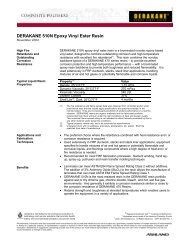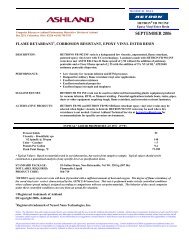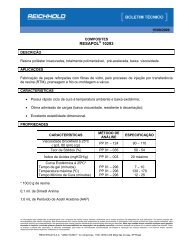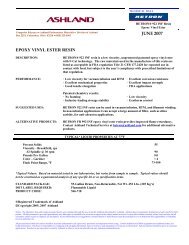Hetron-Ashland Resins
Hetron-Ashland Resins
Hetron-Ashland Resins
Create successful ePaper yourself
Turn your PDF publications into a flip-book with our unique Google optimized e-Paper software.
FURFURYL ALCOHOL RESIN<br />
COMPOSITE<br />
Furfuryl alcohol resin is based on a furan polymer<br />
derivative of furfuryl alcohol. It exhibits excellent resistance<br />
to strong alkalis and acids containing chlorinated<br />
organics and is superior to polyesters and epoxy vinyl<br />
esters in solvent resistance. Furfuryl alcohol resin is<br />
suitable for use up to about 120˚C for many corrosive<br />
applications. However, the furfuryl alcohol material is<br />
not suitable for oxidizing chemicals and should not be<br />
used for chromic or nitric acids, peroxides or<br />
hypochlorites.<br />
Generally, the furfuryl alcohol resin is considered to be<br />
the best for all-around corrosion resistance. Fabrication<br />
and installation of equipment made with HETRON 800<br />
resin requires special techniques that differ from those<br />
used with polyester and epoxy vinyl ester resins. Please<br />
contact HETRON Technical Service at (800) 327-8720<br />
or (614) 790-4399 for assistance.<br />
• HETRON 800: Requires the use of HETRON<br />
803L-1 catalyst.<br />
BISPHENOL A FUMARATE POLYESTER<br />
RESIN COMPOSITE<br />
Bisphenol A fumarate polyester resin is made by reacting<br />
bisphenol A with propylene oxide and fumaric acid<br />
to provide a resin that is particularly resistant to alkali<br />
environments. This resin is recommended primarily for<br />
applications involving hot caustic solutions. It can also<br />
handle acids, selected organic solvents and salt solutions<br />
to a maximum temperature of 120˚C. For specific<br />
recommendations regarding HETRON 700 resin,<br />
contact HETRON Technical Service at (800) 327-8720<br />
or (614) 790-4399.<br />
• HETRON 700: A non-thixotropic unpromoted resin.<br />
PHYSICAL PROPERTIES<br />
The properties in this guide are typical values. These<br />
values, which vary from sample to sample, are based<br />
on tests conducted in our laboratories. Typical values<br />
should not be construed as a guaranteed analysis of<br />
any specific lot or as specification items.<br />
Additional data on each individual resin including liquid<br />
properties and curing information is contained in<br />
the Technical Data Sheet for that resin. <strong>Ashland</strong> maintains<br />
Material Safety Data Sheets for all of its products.<br />
Material Safety Data Sheets contain health and safety<br />
information for assisting you in developing appropriate<br />
product handling procedures to protect your employees<br />
and customers. Our Material Safety Data Sheets should<br />
be read and understood by all of your employees<br />
before using <strong>Ashland</strong>’s products in your facilities.<br />
8<br />
BARCOL HARDNESS<br />
Barcol hardness values are taken as an indication of<br />
surface cure. ASTM standards indicate that FRP equipment<br />
should have a Barcol hardness of at least 90%<br />
of the manufacturer’s published value for each resin.<br />
Experience indicates that Barcol hardness values are<br />
subject to a number of variables. In the case of a<br />
molded surface, these factors may be post cure, the<br />
curvature of a part or the use of one or more plies of<br />
synthetic surfacing veil. For non-molded resin surfaces,<br />
these factors may be paraffin wax, UV inhibitors,<br />
pigments, or other materials added to the resin. On<br />
a severely curved or irregular surface, an accurate<br />
Barcol hardness value may be impossible to obtain.<br />
In such cases, a flat sample using identical fabrication<br />
techniques should be monitored for cure during the<br />
manufacture of the actual part.<br />
Experience indicates that Barcol hardness values of<br />
molded surfaces incorporating synthetic surfacing veil<br />
are less than the values of a comparable glass veil<br />
laminate. Reductions in Barcol hardness values of<br />
five units or more can be expected. Barcol hardness<br />
determination is used to check surface cure and is<br />
often accompanied by an acetone sensitivity test. The<br />
acetone sensitivity test is also valuable in judging cure<br />
when the use of the Barcol instrument is impractical.<br />
In this test, acetone solvent is liberally wiped over the<br />
test surface and allowed to evaporate. A tacky or soft<br />
surface during evaporation indicates under-cure.<br />
THERMAL CONDUCTIVITY (K-VALUE)<br />
The thermal conductivity of a glass reinforced laminate<br />
increases with glass content. The glass has a higher<br />
thermal conductivity than that of the resin. See<br />
Table 2 for thermal conductivity values.<br />
TABLE 2<br />
THERMAL CONDUCTIVITY<br />
(TYPICAL K-VALUES: W/(m•˚C)<br />
Composite Composite<br />
Resin Casting M/M M/Wr/M/Wr<br />
% GLASS 0 25 40<br />
HETRON 942/35 0.18 0.17 0.19<br />
HETRON 970/35 0.18 0.20 0.24<br />
HETRON 922 0.18 0.20 0.22<br />
HETRON 197-3 0.15 0.16 0.19<br />
AROPOL 7240 0.17 0.15 0.19<br />
HETRON 800 0.22 0.18 0.23<br />
HETRON 700 0.17 0.18 0.20<br />
M = Chopped Mat 0.5 kg/m 2 WR = Woven Roving 0.8 kg/m 2



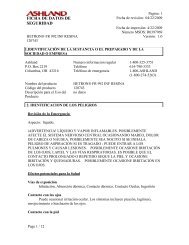
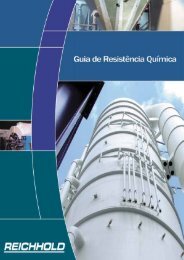
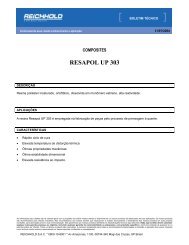




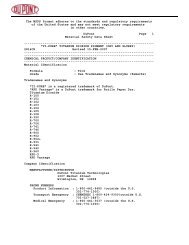
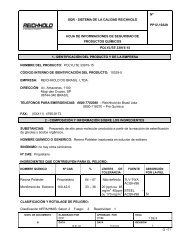
![[ES] - LUPEROX K10 - 2008-04-02](https://img.yumpu.com/40905446/1/184x260/es-luperox-k10-2008-04-02.jpg?quality=85)
